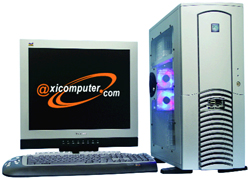
PRODUCT: @Xi MTower 2P64
WEB SITE: www.xicomputer.com
PRICE: Price as tested: $5,055.00
· Dual-Opteron processors
· Nvidia Quadro FX3000 graphics
· Native 32- and 64-bit processing
Sixty-four-bit computing is entering the DCC mainstream with the introduction of Apple's G5, and Intel and AMD having each introduced their own 64-bit processors. In the case of Intel, their Itanium 2 processor is a speed demon, but with one drawback being that it runs 32-bit software in a slower emulation mode. In a few years this probably won't matter, but since much of the current mainstream DCC software is 32-bit, paying the high cost of the 64-bit Itanium 2 might seem unwarranted to many. On the AMD side, they've unveiled their 64-bit Opteron processor, at a price almost ridiculously low. The Opteron also has an advantage over the Itanium 2 in that it can run both 32-bit and 64-bit applications in native mode. The Opteron already seems to be making quite a splash, especially in the enterprise and server arena, and now it's coming to DCC workstations.
@Xi Computer has given the mainstream marketplace one of the very first 64-bit dual-Opteron workstations with their MTower 2P64. @Xi has been around since ‘87, and they don't just do workstations, but also large multi-processor arrays for the visualization market. As an AMD launch partner, they tend to be one of the first vendors to get new AMD-driven workstations on the street.
The system I tested was specifically designed for the DCC market. As tested, the Dual AMD Opteron 242 system had 1024KB L2 multi-way associative cache, 2GB of 333MHz DDR-SDRAM (expandable to 8GB), two-way HyperTransport, AMD 8111/8151 chipset, 1GB Ethernet on board LAN, 2X USB 2.0, 1394 FireWire, 2X ATA 100, 5X 32-bit PCI, codec AC 97 sound, Nvidia Quadro FX 3000 256MB graphics, 420W UL P.S., @Xi MTower tool-free Mighty-Tower and Windows XP Pro.
CPU & GPU - Power Duo
One of the most important components in the @Xi workstation, in addition to the 64-bit dual-Opteron processors, is the Nvidia Quadro FX3000 graphics card. Its inclusion demonstrates @Xi's commitment to building the fastest, high-quality DCC systems. The importance of the FX3000 cannot be underestimated.
THE 64-BIT DIVIDE
One part of the DCC marketplace is already commonly using 64-bit workstations from companies like SGI and now Apple. The SGI systems can come at premium prices, and for some users paying this premium is well worth it. But there is a large group of Windows-based users in the middle of the market that are at the crossroads between their reliable 32-bit systems and the new 64-bit systems, such as @Xi's MTower 2P64. So what exactly is the incentive to cross that divide?
Remember, the 64-bit Intel Itanium 2 processors are pricey and offer less advantage than the price might warrant since they run in 32-bit emulation mode. In the case of the Opteron powered MTower 2P64, I feel taking that leap is almost a no-lose situation, as it natively handles 32-bit applications and has the 64-bit horsepower for the future.
TEST IT YOURSELF
We all read reviews and see specs that seem impressive but are sometimes hard to relate to our real-world workflow. If you want specs, I would highly suggest going to www.spec.org to get the details on the performance of the Opteron chips. The numbers are impressive, especially in multi-processor configurations. However, to bring the performance of the MTower 2P64 down to a more immediate level, here's a test anyone working with digital content can try. It might help you see first-hand what the other side of the digital divide looks and behaves like, or at the very least how your system stacks up to @Xi's 64-bit workhorse.
First, to start the test go to http://www.gsfc.nasa.gov/topstory/2002/1203apollo17.html and download the 60MB high-resolution image of the Earth on that page. This famous image of the Earth is about 4K x 4K pixels, so be patient as it may take some time to download. Place the image in any compositing application you have. For my test, I chose Adobe After Effects. Make the composition HDTV size (1920 x 1080) and turn the layer and composition quality up to full. Create a camera to move across this image at a slight angle looking down at the image, like an orbiting spaceship might see the Earth. Any sluggishness or hesitation you experience tells you a great deal about your system's memory, processors and graphics capabilities. In some cases, if your system is really underpowered you might get error messages when you attempt to load or manipulate this image.
On the MTower 2P64, I had the freedom to move the camera across the image at full resolution, with virtually no hesitation. I rendered out this camera move as a :30 uncompressed 4.3GB AVI file in four minutes and five seconds. If your system can even handle this file and render, compare it to the time for the @Xi workstation. That comparison should speak volumes as to the power of this 64-bit system.
SOONER OR LATER
If you're in the DCC business, sooner or later you will jump to a 64-bit system. The Mac users have a clear path with the G5, and others may chose an Itanium 2 or SGI system. But if bang for your buck is important, and you're ready to jump to 64-bits now, the dual-Opteron MTower 2P64 is an attractive proposition.